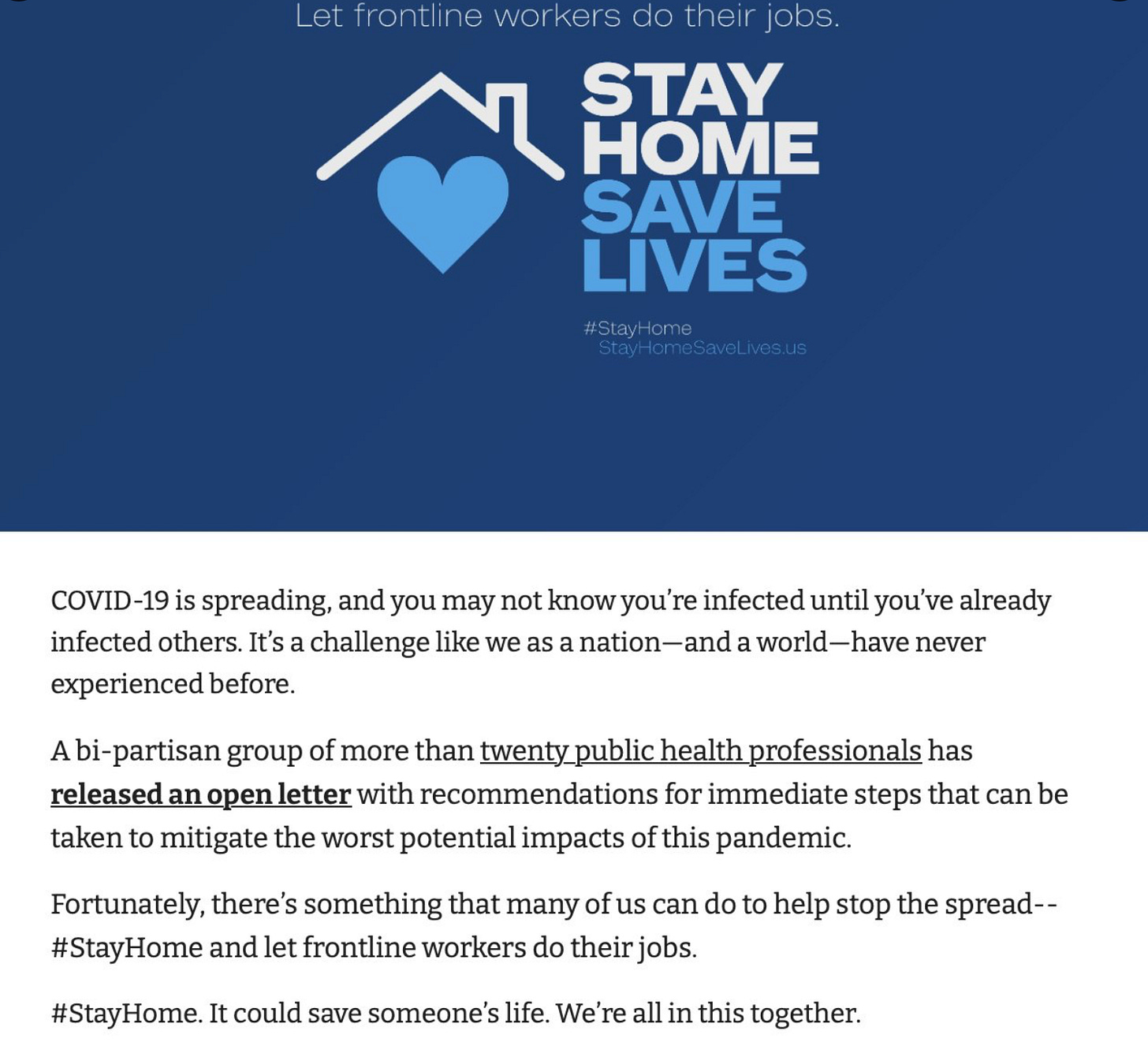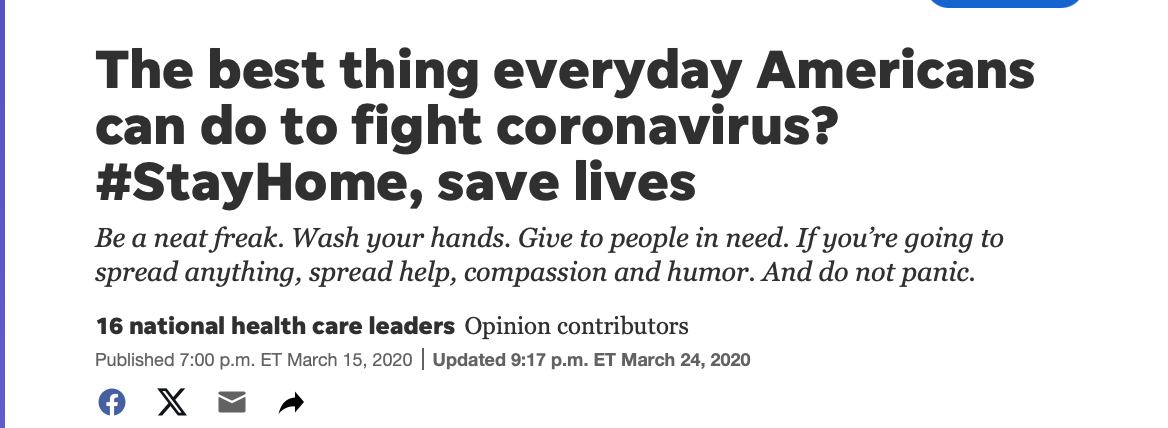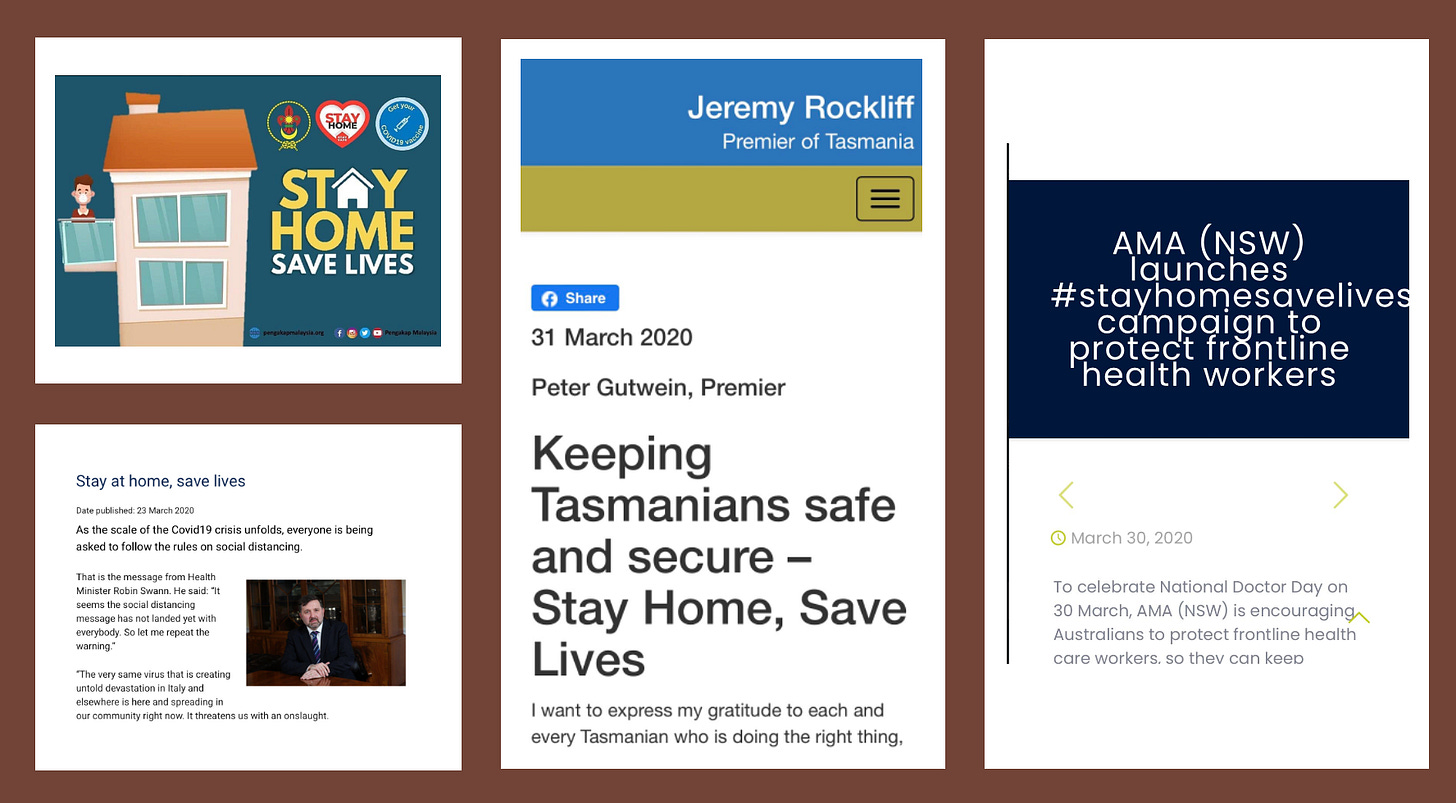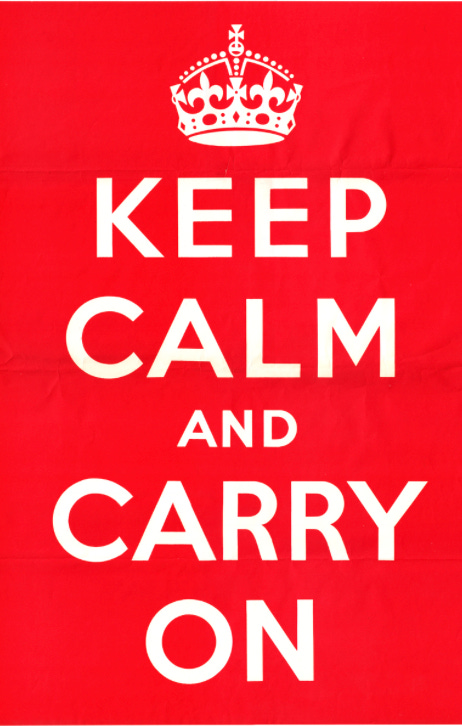"Stay Home, Save Lives" wasn't just a slogan.
It was a centerpiece of a carefully-crafted, hugely successful campaign aimed at persuading the populace that a new disease was “spreading” — a silent disease they may already be “infected” with and could unwittingly pass to others. 😱
Staying home, we were told, was critical to helping frontline workers save people from the spreading disease and making sure hospitals weren’t overrun with suddenly-sick patients.
In the U.S., this effort included an open letter from more than 20 healthcare professionals, published in USA Today on the Ides of March, 2020. (Accessible here and reproduced in full at the end of the post.)
The signatories had zero authority to direct or advise citizens, state/local leaders, & healthcare workers. There is no chance they self-assembled and is it very likely they were readied for priming the population in this manner via various pandemic preparedness efforts and training long before the campaign launched.
Contrary to what this cadre said, there was
No evidence that a new, dangerous coronavirus was transmitting.
No reason to claim the population was immune-naive & unprotected.1
No basis for claiming that older people & those with underlying conditions were at very high risk of death.
No justification for saying communities would be infected "in waves"
No empirical grounds for saying hospitals would be overrun or have insufficient resources.
No reason to deploy testing or the National Guard.
EVERYTHING about their message was a lie.
The brilliance of "Stay Home, Save Lives"—along with its counterpart, “15 Days to Slow the Spread”—lay in how effectively these slogans secured public buy-in and compliance, despite the absence of an immediate or visible threat.
Neither phrase makes sense for an alleged respiratory illness outbreak. Instead, they evoke the kind of messaging used in war, impending asteroid impact, or a collective effort to contain a wildfire.
No concrete proof of a Silent Enemy was required, and the public had little time to question whether stopping the spread was a feasible - or necessary - goal.
Similar messaging appeared in other countries as well, urging citizens to Stay Home, Save Lives for reasons mirroring those given in the U.S..
It’s astonishing, isn’t it? The world was brought to a standstill through screens—words, images, numbers.
No collapsing buildings. No bombs. No guns. No aerial assaults or ground invasions. No weapons of mass destruction—chemical, biological, or otherwise.
And the worst part?
No apologies. Because They aren’t sorry—and would do it all over again.
The best thing everyday Americans can do to fight coronavirus? #StayHome, save lives
15 March 2020 | USA TODAY
The coronavirus pandemic seemed so far away just weeks ago.
No one likes to be isolated and sit at home and be bored.
You want to be near friends as you work from home.
The numbers you’re hearing about the virus seem too big to believe.
You’re worried about your neighbors and the impact on local businesses and workers
You feel healthy, and how much worse can it be than the flu, after all?
COVID-19 is spreading, and you won’t know you’re infected until you’ve already infected others. Right now, you have no immunity to prevent you from getting the disease. It’s especially lethal for older people or those with underlying conditions. This will come to communities in waves and will be a marathon, not a sprint, so pay attention to local events. And our hospitals won’t have sufficient resources — people, beds, ventilators or protective gear — if cases keep spreading as fast as they are in Italy.
But there’s something important you can do: #StayHome
STAY AT HOME as much as possible. It may be in your community now or it may be soon. Until you hear otherwise from health care officials, even if you have no symptoms. That means avoiding play dates, sleepovers, bars, restaurants, parties or houses of worship. Avoid all crowds.
What can you do instead?
You can still take walks outside, shop for essentials and enjoy your online community of friends.
Stay connected in other ways. Check in on your loved ones and friends frequently.
Keep informed about what is happening in your neighborhood.
Give to people in need in your community: supplies for food pantries, financial donations, personal hygiene items.
Buy online gift certificates to your favorite local stores and restaurants — and use them when this is over.
Be a neat freak. Keep everything as clean as possible.
Wash your hands. Early, often, thoroughly.
If you’re going to spread anything, spread help, compassion and humor.
Above all, do not panic. Remember: Like all outbreaks, this too will eventually end.
If you’ve been infected and recovered already, you are highly likely to be immune. If so, you can serve your community in public spaces where others can’t.
To state and local leaders
Prioritize the most vulnerable in your community — the elderly, the sick and those living in close quarters.
Temporarily close bars and restaurants when there is evidence of rising community transmission.
Work with Congress to provide continued economic support for your constituents most urgently affected by the pandemic’s financial blow.
Consider temporary suspension of all commercial air and rail travel.
Ensure the safety and resources needed for your health care workforce. Health care and critical infrastructure workers should have the highest priority for personal protective equipment.
Make rapid expansion of COVID-19 testing a top priority. Open drive-through testing stations and offer at-home care.
Make prescription drug supply and other necessities in your community a priority.
Provide immediate training for all medical providers to join the effort wherever they can be most useful.
Honor cross-state medical licensing for all health care providers until the pandemic is over.
Prepare large spaces (stadiums, hotels) to become quarantine residences, as needed.
Coordinate with the National Guard to provide surge intensive-care-unit capacity for communities in need.
Create fever clinics for triage.
Reevaluate any regulations that impede the above (or below).
To health care workers
We know you are in uncharted waters and are standing on the front lines. All of us depend on your training, your compassion, your commitment and your untapped capacity.
If you have not yet joined this fight, please reach out to your local hospital and find out how you can enlist.
Contact telemedicine platforms and offer your services.
Stop all elective surgical and medical procedures now.
Send people home if it’s safest for them to be at home.
Reinforce the benefit of staying home and getting tested.
Help the people on the front lines do their jobs. Focused and united, we can avoid the worst possibilities. It’s up to all of us. As a country, we can overcome this together.
#StayHome
Afterword (added 16 March 2025)
The simplicity and rhythm of Stay Home, Save Lives is akin to Keep Calm, Carry On - the slogan used on posters produced by the UK government in 1939 as morale boosters in advance of anticipated aerial attacks on major cities and sites. Whomever is responsible for generating Stay Home, Save Lives almost certainly had this and other taglines from war efforts in mind.
Looking back, ‘herd immunity’ and ‘natural immunity’ also supported the unsubstantiated claim that a new pathogen was spreading. See Novelty and immunity: Why were we so blind to the obvious?









"Stay home, save lives" unless you had to go to the big grocery store or Home Depot in my community. The small stores and restaurants, little specialty shops, and schools would kill you but the big stores were safe. Don't forget to follow the arrows in the grocery store. There were some seriously crazy ideas but lots of groups together managed to scare enough of the populace early that many people bought it. You know it will happen again.
To this day it astonishes me how many people still believe all that BS. You may be feeling completely fine, but may harbor a disease that you can spread to many people and kill them. As Michael Carter said before me, if you go to a small shop you may kill others, but Home Depot is fine, as long as you follow the arrows and walk down the alleys in only one direction. Above all, do not panic, but we need to behave doing everything in panic mode. Unbelievable!